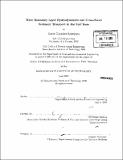| dc.contributor.advisor | Ole Secher Madsen. | en_US |
| dc.contributor.author | González Rodríguez, David, Ph. D. Massachusetts Institute of Technology | en_US |
| dc.contributor.other | Massachusetts Institute of Technology. Dept. of Civil and Environmental Engineering. | en_US |
| dc.date.accessioned | 2010-02-09T16:51:19Z | |
| dc.date.available | 2010-02-09T16:51:19Z | |
| dc.date.copyright | 2009 | en_US |
| dc.date.issued | 2009 | en_US |
| dc.identifier.uri | http://hdl.handle.net/1721.1/51613 | |
| dc.description | Thesis (Ph. D.)--Massachusetts Institute of Technology, Dept. of Civil and Environmental Engineering, 2009. | en_US |
| dc.description | Includes bibliographical references (p. 167-171). | en_US |
| dc.description.abstract | Coastal erosion and, more generally, evolution of the beach morphology are major coastal engineering problems. Changes in beach morphology mostly occur in the nearshore region, or surf zone. They are caused by the local imbalance of sediment transport, both in long-and cross-shore directions. Cross-shore sediment transport is the small difference between two large components: the on- and offshore transport rates. Both components must be very accurately predicted in order to predict their difference with reasonable accuracy. The physics of on- and offshore sediment transport is however not well understood, and the keystone in its understanding is the characterization of the nearshore wave boundary layer. The goals of this thesis are to investigate the hydrodynamics of nearshore wave boundary layers and to develop an analytical model to predict cross-shore sediment transport rates, both in oscillating water tunnels (OWTs, a commonly used type of experimental facility) and in the sea. This thesis presents a simple conceptual model of the nearshore boundary layer mechanisms responsible for sediment transport. Bed shear stresses are predicted by using a time-varying friction factor. Bedload predictions by this simple model agree with sheet flow measurements if the bed roughness is used as a fitting parameter. To overcome the need for a fitting parameter, a detailed analytical model of the OWT boundary layer hydrodynamics, based on assuming a certain spatial structure and temporal dependence of the eddy viscosity, is derived. | en_US |
| dc.description.abstract | (cont.) The hydro-dynamical predictions and the corresponding bedload sediment transport predictions by this analytical model agree with the available sheet flow experimental data, with the bed roughness being consistently characterized by the total mobile-bed roughness. Unlike the OWT case, where waves do not propagate, waves in a flume or in the sea are propagating. We outline the extension of the analytical model to propagating waves and quantify the hydrodynamical and bedload sediment transport differences between propagating and non-propagating waves. These differences are significant and need to be accounted for when interpreting OWT results. | en_US |
| dc.description.statementofresponsibility | by David González Rodríguez. | en_US |
| dc.format.extent | 171 p. | en_US |
| dc.language.iso | eng | en_US |
| dc.publisher | Massachusetts Institute of Technology | en_US |
| dc.rights | M.I.T. theses are protected by
copyright. They may be viewed from this source for any purpose, but
reproduction or distribution in any format is prohibited without written
permission. See provided URL for inquiries about permission. | en_US |
| dc.rights.uri | http://dspace.mit.edu/handle/1721.1/7582 | en_US |
| dc.subject | Civil and Environmental Engineering. | en_US |
| dc.title | Wave boundary layer hydrodynamics and cross-shore sediment transport in the surf zone | en_US |
| dc.type | Thesis | en_US |
| dc.description.degree | Ph.D. | en_US |
| dc.contributor.department | Massachusetts Institute of Technology. Department of Civil and Environmental Engineering | |
| dc.identifier.oclc | 495729505 | en_US |
